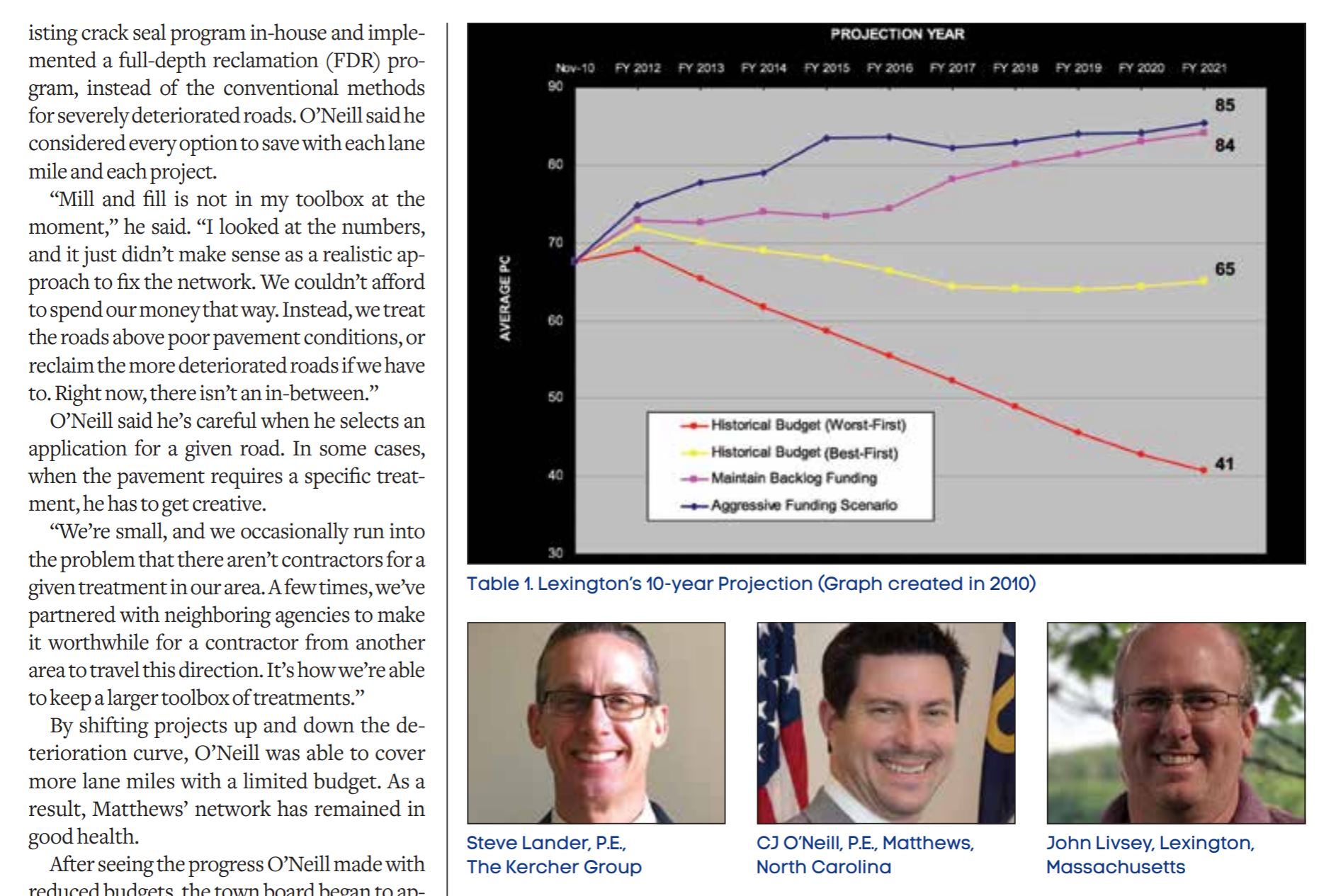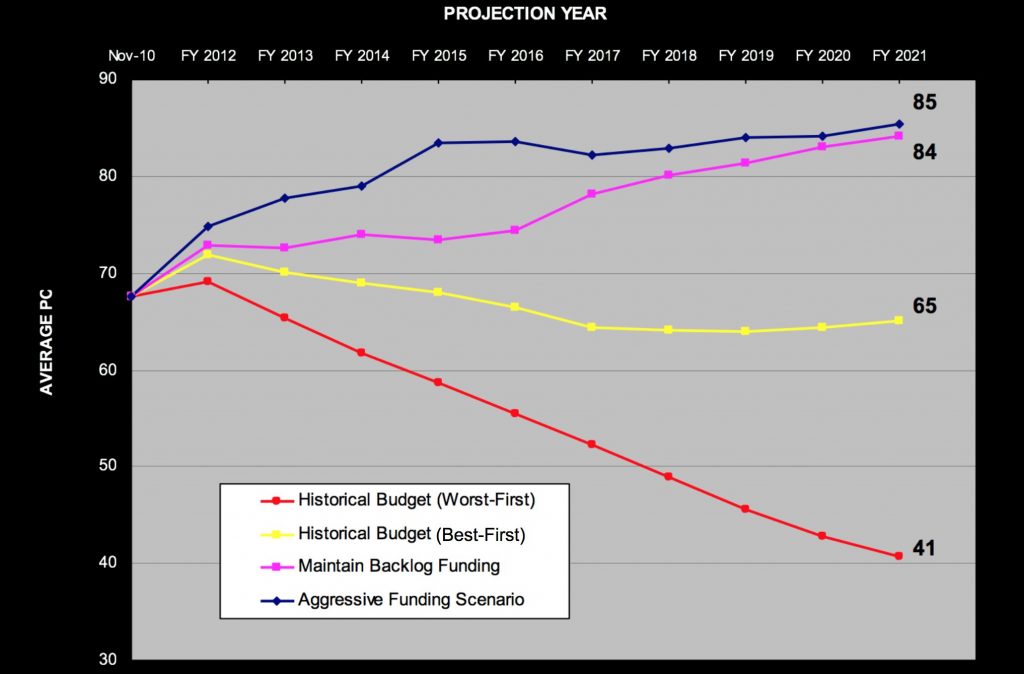Stretch Budgets Further After COVID-19 with Road Network Life Support
BY PPRA

A recent study by the PPRA found that of those surveyed, 71 percent of agencies expect decreased gas tax revenue to considerably or somewhat impact their budgets in 2021.
The same survey reported that as a result of decreased gas tax revenues, agencies anticipate fewer local road improvements, less aggressive pavement management programs, delays in equipment purchases or replacements, and delayed projects from 2021.
Across the country, each community is dealing with differing circumstances, but one prevailing fact remains: Any negative impact to already stretched budgets could have massive effect on backlogs now and into the future—unless road managers start treating their networks differently.

John Livsey, Lexington, Massachusetts
Ahead of the Curve Webinar Interviews
We set out to learn what city, county, state agencies around the country are doing to prepare their networks for 2021 and the years following this economic downturn. As a part of the 2020 PPRA webinar series, Ahead of the Curve, we asked three high-performing agencies and their consulting partners how each community reacts to reduced revenues, and what advice they would share with agencies around the country facing budget cuts. To hear additional information on any of the stories in this article, visit roadresource.org/webinars.
The Risk We Run: Losing the Battle for Service Life
For the preservationists out there, the risk pertaining to reduced revenues from the impact of COVID-19 is all too familiar: If communities don’t gain ground for their networks every year, they contribute to an ever-growing trend of deterioration and set themselves up for a growing backlog. That risk grows when budgets are threatened and plans are altered.
Steve Lander, P.E., local agency pavements practice leader with The Kercher Group shared the biggest threat to network progress, due to the economic downturn, in his opinion. He said the problem is that many agencies will reactively cut or delay their preservation programs due to decreased budgets. This response, he says, can have big implications for the long run.
“Agencies may decide to complete only their most distressed road projects, instead of preserving their roads,” he said. “The worst-first mentality is exactly the opposite of what their networks need to survive reduced budgets.”
He said, “You can’t solve a network problem with a project solution.”
Lander said, at this time, agencies should be using an optimization project selection approach to determine the best mix of fixes for their roadway networks. Optimization maximizes the benefit across the entire roadway network by selecting the optimal percentage of each maintenance activity per year based on the benefit cost ratio, the condition of the network and the funding allocation. This is how to accomplish the right treatment, for the right road, at the right time. Essentially, if we do one project at the right time, we save money over the life of that roadway. If we do all projects at the right time, then this has a compounding effect.
The goal of these programs is to add service life to their networks, cover more ground and keep good roads in good shape—because you can’t control how long the effects of economic recession could last. The effects of a poor reaction early-on could set the stage for an even more unmanageable backlog in just a few years.
“One of the first building blocks that agencies can use to check network health is remaining service life,” Lander said. “Every agency should understand the overall health of their network, and how each annual plan impacts it. It won’t write your plan for you, but it can be a great first step to understanding the problem. Especially as agencies look toward reduced budgets, getting ahead of the curve will only make things easier in the future.”
Remaining Service Life (RSL) can be used ahead of budget cuts to understand network health, but it is also designed to help agencies leverage even reduced budgets. Learn more about remaining service life, and use the free RSL calculator at the RoadResource website.

CJ O’Neill, P.E., Matthews, North Carolina
Preservation Puts North Carolina Network on Life Support
With many agencies facing cuts, this problem could become even more prevalent: You’ve got too many road miles, and not enough money.
CJ O’Neill, P.E., the public works director of Matthews, North Carolina, is no stranger to this predicament. When O’Neill first became town engineer in 2014, the Matthew’s town board had allocated a budget of $500,000 per year for road projects. The board believed O’Neill and his team would be able to maintain the network of 100 centerline miles at a pavement condition index (PCI) of 78.
“It just wasn’t going to work,” O’Neill said. “When I first got there, they used only patching, milling, resurfacing and some crack seal. If we’d stuck to that funding plan and the reactive maintenance from the past, the network would be in failing condition in no time.”
O’Neill set to work assembling a plan that would prevent further deterioration, so that the town didn’t “dig themselves into a deeper hole” or contribute to a growing backlog of projects. The plan began with a streets survey and partnership with the Kercher Group to identify and optimize asset management.
“After we gathered the data, we learned the network needed $880,000 annually to meet expectations,” O’Neill said.
This information was surprising news to the members of the Matthews town board. After learning more about pavement preservation, and the effects that a minimal budget would have on the network, the town board raised the original budget to $600,000.
“It was still not where we needed to be, but it was a start,” O’Neill said.
Ultimately, O’Neill’s long-term goal was to advocate for sufficient spending to improve the network; but in the meantime, O’Neill would have to keep Matthews’ roads healthy until more funding could begin to flow. Essentially, he was putting the network on “life support” until more help could arrive.
O’Neill began implementing surface treatments such as rejuvenators and cape seals. To save even more on budgets, he brought the existing crack seal program in-house and implemented a full-depth reclamation (FDR) program, instead of the conventional methods for severely deteriorated roads. O’Neill said he considered every option to save with each lane mile and each project.
“Mill and fill is not in my toolbox at the moment,” he said. “I looked at the numbers, and it just didn’t make sense as a realistic approach to fix the network. We couldn’t afford to spend our money that way. Instead, we treat the roads above poor pavement conditions, or reclaim the more deteriorated roads if we have to. Right now, there isn’t an in-between.”
O’Neill said he’s careful when he selects an application for a given road. In some cases, when the pavement requires a specific treatment, he has to get creative.
“We’re small, and we occasionally run into the problem that there aren’t contractors for a given treatment in our area. A few times, we’ve partnered with neighboring agencies to make it worthwhile for a contractor from another area to travel this direction. It’s how we’re able to keep a larger toolbox of treatments.”
By shifting projects up and down the deterioration curve, O’Neill was able to cover more lane miles with a limited budget. As a result, Matthews’ network has remained in good health.
After seeing the progress O’Neill made with reduced budgets, the town board began to appreciate the importance of optimized network management. In the years following 2014, when more funding became available, the board increased O’Neill’s budget to begin gaining ground for the community.
“For agencies worried about funding next year, as a result of COVID, I’d say they should really consider preserving the assets they have, rather than spend on expensive projects,” O’Neill said. “It will get you a lot further with less.”

Steve Lander, P.E., The Kercher Group
Communication Keeps Clear Channels
Too often, even the best pavement managers run into difficult-to navigate hurdles—especially when purse strings are tight. Agencies around the country are worried that reactive decision-making could get out of hand if elected officials or taxpayers opt to cut road budgets in favor of other spending areas.
The trick, according to John Livsey, town engineer in Lexington, Massachusetts, is to keep everyone informed and educated on the issues at hand.
Over the last 10 years, Livsey and his team have improved their network health from 68 to 85 PCI. Lexington addresses 20-25 percent of its roads every year, and has reduced its backlog from $35 million to $7.5 million. What may be the best part: Livsey’s department has seen a “nearly total” drop in public complaints with their new program. Much of this success Livsey attributed to his communications plan.
“We have lots of presentations to town leaders,” Livsey said. “It’s important that they understand the plan, so that it doesn’t get altered or changed for political reasons.”

Lexington’s 10-year Projection (Graph created in 2010)
Political leader education is important to ensure elected officials understand the “method to the madness.” Livsey and his team provide a yearly report and presentation documenting the success of their annual planning, and project future impacts. This in-depth education provides rationale and justification to decision makers. Plus, by equipping elected officials with the background understanding of road network management, Livsey and his team are equipping their elected officials with the knowledge they need to answer calls, complaints or questions from their constituents. As any elected official knows, having the information is always better than not having it.
“We take time to educate residents as well—it’s not just about traffic control and expectations, but we want to make sure they understand why we’re treating their roads with a given treatment, and why it matters in the big picture,” Livsey said.
For free, pre-built tools that agencies can put to use, the RoadResource website has a suite of public-friendly videos and PDFs explaining network management.
Put it to Work in 2020 & 2021
Although the outlook for the next few years may be uncertain, there are plenty of examples that road managers can learn from to better navigate the changes ahead. For information and updates on initiatives to revive infrastructure after the 2020 recession, visit transportation.org.
If your agency is looking for new ways to learn and adapt to budgetary changes, visit RoadResource.org for free tools, information, and network optimization calculators to begin putting these and many more concepts to work for your community.
